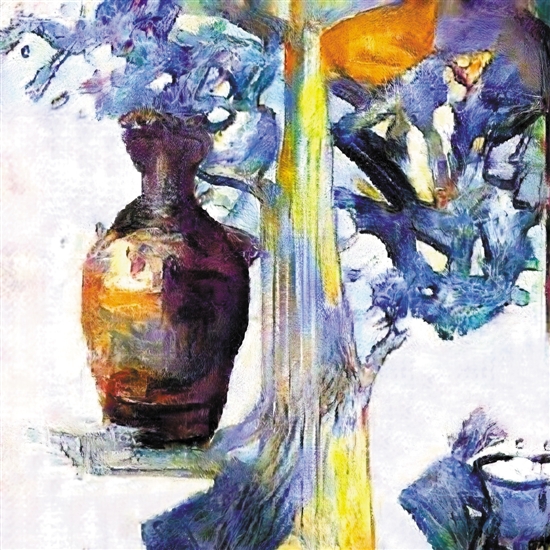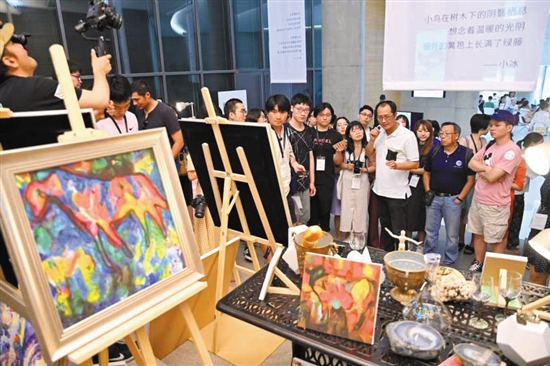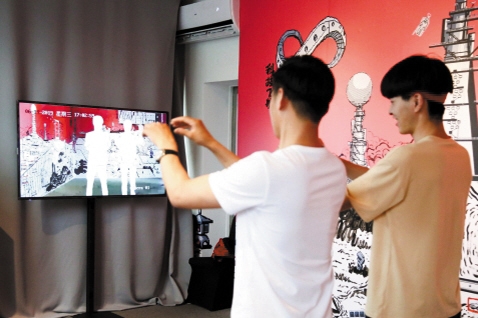AI has learned artistic creation, will artists disappear?
Piano robot Special Olympics is playing and singing.

The painting of Microsoft robot "Xiao Bing"

"Xiao Bing" solo exhibition held in Central Academy of Fine Arts

Participants in the "to be no.1" game at the World Artificial Intelligence Conference.

The audience participated in the live interaction of Li Yuansu’s AI work "Nanjing West Road Style Migration"
Yangcheng Evening News reporter Jing He
"Humans can’t be controlled by artificial intelligence, because humans can’t create smarter creatures than humans." Ma Yun said.
"I disagree with you very much. We can create something smarter than human beings, but not necessarily people." Musk said.
On August 29th, at the opening ceremony of the 2019 World Artificial Intelligence Conference in Shanghai, Ma Yun and Tesla CEO elon musk had a tit-for-tat "quarrel".
Regardless of whether artificial intelligence is smarter than human beings, it is an undeniable fact that AI is infiltrating into every corner of human life, even including the field of artistic creation that was once regarded as exclusive to human beings. If the cooperation between artists and AI only creates a new means of expression, but AI itself learns to create art, which opens the door to a new world.
What does AI’s participation mean for creative and imaginative humanistic artistic creation? How should we define "art" today? Is it possible for everyone to become an artist in the future? Artists who are at the forefront of the trend have given us their own answers.
1 Smart conference live experience: somatosensory remote control and AR "crossing" are human-computer interaction.
Walk into the IBM exhibition area of the 2019 World Artificial Intelligence Conference and raise your hands above your head to make a gesture of love. With the countdown to 54321 over, you will successfully activate an astronaut named CIMON to "land on the moon". On the screen, the astronaut will follow some of your body movements to "swing" his body — — He is representing you "landing on the moon". You can also download photos of yourself "landing on the moon" and post them on social platforms. This CIMON is the first "AI astronaut" launched by IBM. It helped man land on the moon for the first time 40 years ago.
In the "to be no.1" exhibition area where Shangtang Technology cooperates with the Forbidden City, as long as you make a gesture, you can "cross" to take a photo with Confucius in ancient times, and you can also use face recognition technology to "transform" into a scholar who is in Beijing to take an exam and take an ancient imperial examination.
The artwork "Nanjing West Road Style Migration" created by young painter Li Yuansu using AI technology is also a popular interactive project in the exhibition hall. When the audience enters the exhibition area, the camera will capture the corresponding pictures, which are processed by human detection, background segmentation, human-computer interaction and other technologies, and then the computer will combine the study of the painter’s past works and make real-time creation. On the display screen, the audience can see their own figure and become a stylized image in real time. Although these works are only based on the creation of man-machine cooperation, it is undeniable that AI has penetrated into all aspects of human life.
2 Interaction triggers reverse trigger: artists begin to think about "how to express intelligent objects"
In fact, in the AI era, the integration of human artistic creativity and AI has become a "new trend", and there have been many interactions between them.
In 2017, Google launched Autodraw, a tool that can help people draw stick figures. With just a few strokes, the algorithm can identify what you want to draw and optimize it for you. In 2018, the digital creation studio OUCHHH launched an exhibition named "Poetic AI" at the Paris Art Center, France. By learning the articles of scientists who have changed human history, AI transcoded them into words and images, and then projected them into a space of 3,300 square meters through 136 projectors. The effects of light and motion are also automatically generated through preset algorithms, which can provide an immersive experience combining sound, light and shadow for the audience. Also in 2018, at Christie’s auction, the painting "The Portrait of Edmund Bellamy" created by AI was taken at a price of 432,500 US dollars (about 3.01 million yuan).
Interestingly, Li Yuansu pointed out a new phenomenon: artists used to like to express figures, flowers, birds and mountains. When AI appeared, some people began to think about "how to express intelligent objects". "In the past, artists may describe the sparkling water, but what excites contemporary artists may be the flashing LED lights and the computing interface of supercomputers." He believes that "these are the reverse triggers of artificial intelligence on artistic creation inspiration."
3 Constantly unlocking new skills: Microsoft Xiao Bing, who can write poetry and sing, also learned to draw.
In May 2014, Xiao Bing, an intelligent chat robot launched by Microsoft (Asia) Internet Engineering Institute, was born. This is a girl who pays attention to EQ and takes an emotional route. In the past five years, Microsoft Xiao Bing has been unlocking new skills. She published a collection of poems, learned to sing, can host programs, and learned to draw as an "supernumerary" graduate student of the Central Academy of Fine Arts. At the World Artificial Intelligence Conference, Xiao Bing’s paintings attracted many audiences with unique style.
The painter Xiao Bing’s debut time is not long, but he has become a minor celebrity. In May this year, Microsoft Xiao Bing, under the pseudonym of "Xia Yubing", exhibited her works for the first time at the 2019 Graduate Exhibition of Central Academy of Fine Arts, and became an "supernumerary" master graduate of Central America.
After graduation, Microsoft Xiao Bing is "non-stop". From June 15th to July 15th this year, the cross-border exhibition of contemporary art "Xiao Bing, Painting for a Period" was held in Liangzhu Culture and Art Center, Hangzhou, featuring paintings created exclusively by Xiao Bing and VR immersive works created interactively by new media artists Zhou Linwei and Xiao Bing. Later, Xiao Bing’s first solo exhibition "Possibility World" was held in the Art Museum of the Central Academy of Fine Arts.
Now just go to Xiao Bing’s homepage and enter a simple text on the page to activate her, and you can entrust Xiao Bing to make a painting for you. After extracting intention, stimulating creative inspiration, selecting content theme, trying to compose the picture, drafting line drawing modeling, painting the bottom color, deepening the picture level and polishing the details repeatedly, the painting created by Xiao Bing can be released in three minutes.
According to the Microsoft Xiao Bing team, Xiao Bing spent 22 months studying the paintings of 236 famous painters in the history of art. When inspired by texts or other creative sources, Xiao Bing can independently complete 100% original paintings. This originality is not only reflected in composition, but also in color, expressiveness and details. Li Di, the head of Xiao Bing’s team, stressed: "Xiao Bing’s painting ability is not based on filters and migration technology — — That is, search the picture of the corresponding theme from the landscape library, and then use the oil painting filter to process it. " He said that painting model is the third kind of AI model after text and pronunciation, and it is also the longest and hardest project.
Qiu Zhijie, Dean of Experimental Art College of Central Academy of Fine Arts, spoke highly of Xiao Bing’s works. "Xiao Bing’s works are diverse in style, skillful in technique, fast in painting and large in quantity, from which we can find many good paintings." Qiu Zhijie said, "We set several aesthetic rules for artificial intelligence, and it will use these rules to combine endless changes. If you set it to ‘ Do not repeat ’ The instructions, AI actually has a greater chance to get rid of the routine. "
Xiao Bing is developing towards the route of piano, chess, calligraphy and painting, which makes her look more like a "person". In May 2017, Xiao Bing’s original poetry collection "Sunshine Lost Glass Window" was published, which is the first poetry collection created entirely by AI in human history. This year, Xiao Bing and the poet’s poetry collection "Flowers are Silence of Green Water" came out, which is also the result of writing poems jointly by man and machine. About 200 poems were finally selected from 6,000 submissions.
However, whether it is poetry or painting, Xiao Bing’s works still clearly bear traces of AI. For example, there is a lack of effective transition between poetic images, irrationality between logics, and inconspicuous poetry, etc. Although Xiao Bing’s team said that Xiao Bing’s paintings are close to human level, the audience can still see with the naked eye that Xiao Bing’s works have no three-dimensional sense of oil painting, appear more flat, and can’t see the lines of a painting.
4 human beings are hard to be replaced: AI singers who lack emotion are hard to impress people.
On the evening of August 29th, when the virtual singer Tianyi Luo’s singing sounded in the Shanghai Benz Cultural Center, the familiar Jasmine seems to be a little strange. As the most famous virtual singer in China, Tianyi Luo has held ten thousand people’s holographic concerts for three years in a row, creating a precedent of "domestic virtual singer AR live broadcast on a large variety show".
Then came the piano robot Special Olympics from Italy. I saw his 53 fingers dancing on the keys quickly and accurately, playing and singing Perfect by British singer ed sheeran, Special Olympics’ hard-core head and unique singing voice, leaving a different memory for the audience.
At the first audio-visual feast of AI and art in China, AI brought us into a brand-new art world. Man-machine interaction, motion capture, virtual reality, holographic images, three-dimensional images and other technical means are combined with music, dance, opera and other artistic forms to jointly create a mirror world of light and shadow, and a visual spectacle of illusion.
However, when you listen carefully, the songs of Tianyi Luo and Special Olympics are still a little less natural and agile. Although the ups and downs of the vocal range can be realized by AI, the free flow and emotional expression of human voices can never appear on AI robots.
Artificial intelligence has greatly broadened the boundaries of art and made machines more like people. But "0" and "1" can’t teach machines to have unique human emotions. Without the artistic expression of emotion, it is difficult to really hit the hearts of the audience, and of course, it also makes people realize the "irreplaceable" of human voice.
On the Zhihu, someone asked: "What is the significance of developing AI production art?" Xiao Yao, the author of the science fiction "AI Trek", replied: "Artists will not disappear. AI will only eliminate some guys who are not innovative, and those who are truly capable and talented will only get better and better. If the artist’s creative enthusiasm will be hit by AI, it only means that it is normal for these guys to be eliminated. It’s like the appearance of a car is bound to hit ‘ Camel Xiangzi ’ Children, and part of ‘ Camel Xiangzi ’ I learned a driver’s license and became a taxi driver. "
interlinkage
Dialogue with Li Yuansu — —
Art still needs to return to the level of humanity and flesh.
Yangcheng Evening News: When did you start using AI for artistic creation? Are you satisfied with the results of this creation?
Li Yuansu: This is the first time I have combined with AI to create. With the theme of artificial intelligence, each of the three works has a clear experimental purpose: the mural of "AI Hegemony" is a struggle between hand painting and digital printing on the old media of "mural"; The game "AI Hegemony" uses the same material as murals, and the form is the game interaction mode in the "pre-AI era"; "Nanjing West Road Style Migration" uses contemporary cutting-edge AI technology. In this work, AI learns the artistic style independently and makes his own real-time creation. The three works show the aesthetic characteristics of different media from manual to digital, from static to interactive. The final result is to meet the expectations.
Yangcheng Evening News: What new possibilities does AI offer for artistic creation?
Li Yuansu: If we sum up the traditional appreciation of art as a group of relationships between artists and audiences, then this group of relationships in the AI era will be expanded, and we will have various combinations such as "machine creation-audience watching", "artist creation-machine watching" and "machine creation-machine watching". Of course, it is not easy to discuss whether machines can produce emotions and how to define emotions, but it is my purpose to do these works to explore along these lines.
Yangcheng Evening News: What do you think of the future artistic creation trend?
Li Yuansu: Now it seems that the role of artificial intelligence technology in human art will not be subversive. The role of AI in human art is expansion. It brings unprecedented media relations, creative materials, inspiration and great help. It allows human beings to better understand themselves in the mirror of science and technology. However, for the "machine art", recent years may only be the time when it originated.
Yangcheng Evening News: When artistic installations can continuously create works without the participation of artists, how should we treat these works of art? Is the painting made by artificial intelligence a real work of art?
Li Yuansu: The relationship between art and audience is consensual, and art is a condensed form of emotional experience. So, as long as someone is willing to admit that it is a work of art, it is. This is in essence. However, whether it is recognized academically or accepted by the art market will definitely lead to different situations and twists and turns.
Yangcheng Evening News: Is the essence of science and technology art art or technology? Will future artists be replaced by creative artificial intelligence machines?
Li Yuansu: Science and technology art is still art. In fact, today’s art is also inseparable from "technology". For example, canvas is a textile technology, and pigments need mineral and chemical technology, including photography and video, which were once high-tech — — Humans will always take everything at hand to create art and "play" art.
Artistic creation will not be replaced by machines. For creators, the first thing in art is to serve themselves, and it is an act of expressing emotions and recording experiences. In the contemporary era when information technology subverts the way of life, we are still trapped in the warmth of manual work. At present, only by returning to the level of humanity and flesh can the new media art gain the recognition of more audiences, and the pure aesthetics of science and technology is cold to most people.